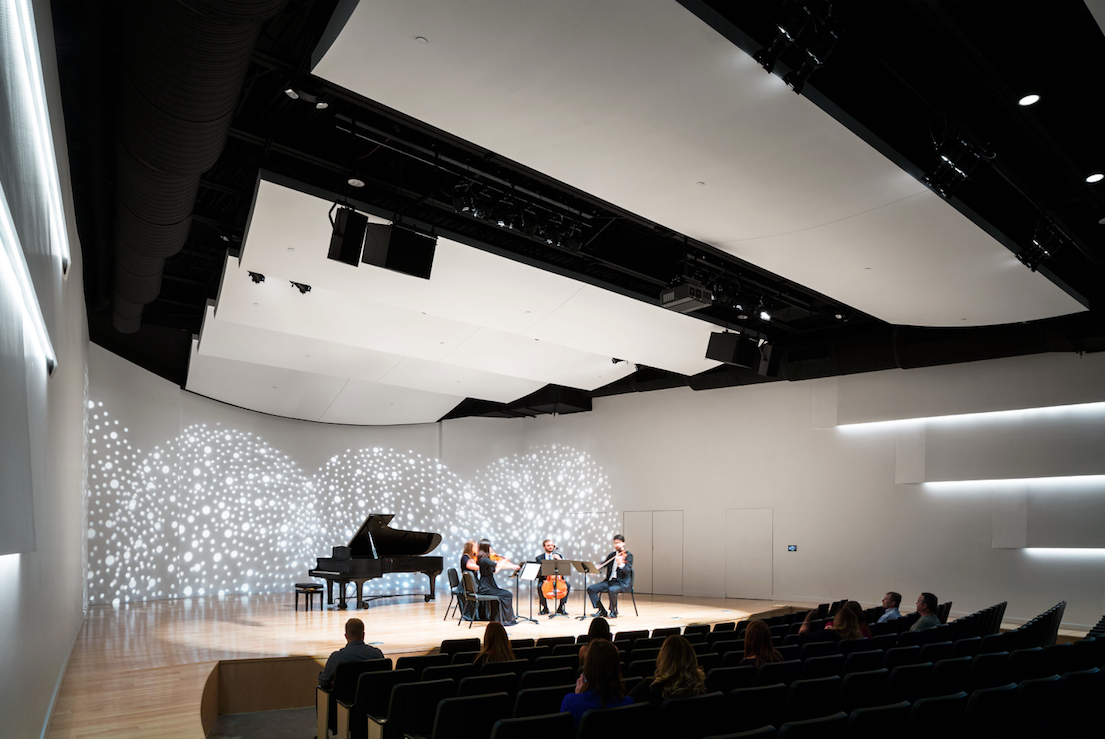A couple of years ago, Ruth Meints, Executive Director of the Omaha Conservatory of Music, got a notice from the organization’s landlord that the conservatory would have to vacate its space in a local community center by January 2016. Meints, who also teaches violin and viola at the OCM, wasn’t crazy about the space to begin with—it was small and had acoustical problems—but it was home. What to do?
Luckily, Meints happened to be in touch with David Lempke, HDR’s Vice President and Design Principal, and Lempke happened to be aware that Temple Israel had built a new facility in town, which freed up its old building as a possible home for the conservatory.
The old temple, built in 1952, was in decent shape, Lempke recalls. The conference room, administrative offices, and classrooms could be reprogrammed relatively easily for the conservatory’s needs for studios and teaching spaces. But the windows and roof needed to be replaced. Many of the walls lacked insulation or vapor barriers. The HVAC system had no humidity control—essential to protect the musical instruments—and would have to be replaced.
After $15 million in reconstruction, the new 40,000-sf conservatory opened in late 2015, well ahead of the deadline. The sanctuary, with its sloping floors and sidewalls, was converted to a shoebox-shaped performance center with a 48-foot-wide stage. Irwin Seating Company installed telescopic seats whose backs and bottoms fold up and retract, bleacher-style, into the back wall. This more than doubled the seating capacity to 500.
These days, Meints can lead her Violin Sprouts - the program she pioneered in 2013 for young musicians - under much improved conditions.
 After a devastating fire, Congregation Kehilath Jeshurum in New York reconsidered how to expand its sanctuary (pictured in its rebuilt state) and its school. Image: Chris Cooper.
After a devastating fire, Congregation Kehilath Jeshurum in New York reconsidered how to expand its sanctuary (pictured in its rebuilt state) and its school. Image: Chris Cooper.
OUT OF THE ASHES
Five years ago, FXFowle Architects was overseeing the renovation of Congregation Kehilath Jeshurun’s synagogue, in the Upper East Side of New York City, when the roof went up in flames. The fire severely damaged the century-old sanctuary but spared the lower school and the limestone neo-Classical façade. The fire prompted the institution to reconsider how to grow its facilities to meet the needs of its congregation and students.
Ann Rolland, FAIA, Principal with FXFowle, says that her firm recommended moving the 1,150-student school and gym to higher floors, which would more clearly delineate the functions of the building along its horizontal and vertical axes. That move required erecting a complicated structural system to support the two-story addition and relieve pressure on the synagogue’s walls during construction.
FXFowle brought the 18,000-sf sanctuary up to code. Italian crafts workers, using traditional methods, recreated columns, egg-and-dart molding, and new scagliola finishes on the main ark and new column enclosures. The steel reinforcement within the sanctuary had to be positioned to minimize seating loss for congregants.
This 80,000-sf project, which was completed in the summer of 2015, came in on budget at $40 million, says Rolland. ZDG LLC was the cost estimator; project management firm VVA was owner’s representative.
The synagogue’s worst fear—that its congregation would drift away during the reconstruction—proved to be unfounded. “This project was about rebuilding and revitalizing a community,” says Rolland.
Related Stories
| Jan 2, 2015
Construction put in place enjoyed healthy gains in 2014
Construction consultant FMI foresees—with some caveats—continuing growth in the office, lodging, and manufacturing sectors. But funding uncertainties raise red flags in education and healthcare.
| Dec 28, 2014
AIA course: Enhancing interior comfort while improving overall building efficacy
Providing more comfortable conditions to building occupants has become a top priority in today’s interior designs. This course is worth 1.0 AIA LU/HSW.
| Nov 26, 2014
USITT Selects Bahrain National Theatre for Honor Award
The Bahrain National Theatre will be recognized with an Honor Award by the United States Institute for Theatre Technology (USITT) in 2015.
| Nov 18, 2014
Fan of the High Line? Check out NYC's next public park plan (hint: it floats)
Backed by billionaire Barry Diller, the $170 million "floating park" is planned for the Hudson River, and will contain wooded areas and three performance venues.
| Nov 17, 2014
'Folded facade' proposal wins cultural arts center competition in South Korea
The winning scheme by Seoul-based Designcamp Moonpark features a dramatic folded facade that takes visual cues from the landscape.
| Oct 23, 2014
China's 'weird' buildings: President Xi Jinping wants no more of them
During a literary symposium in Beijing, Chinese President Xi Jinping urged architects, authors, actors, and other artists to produce work with "artistic and moral value."
| Oct 20, 2014
UK's best new building: Everyman Theatre wins RIBA Stirling Prize 2014
The new Everyman Theatre in Liverpool by Haworth Tompkins has won the coveted RIBA Stirling Prize 2014 for the best building of the year. Now in its 19th year, the RIBA Stirling Prize is the UK’s most prestigious architecture prize.
| Oct 16, 2014
Perkins+Will white paper examines alternatives to flame retardant building materials
The white paper includes a list of 193 flame retardants, including 29 discovered in building and household products, 50 found in the indoor environment, and 33 in human blood, milk, and tissues.
| Oct 15, 2014
Harvard launches ‘design-centric’ center for green buildings and cities
The impetus behind Harvard's Center for Green Buildings and Cities is what the design school’s dean, Mohsen Mostafavi, describes as a “rapidly urbanizing global economy,” in which cities are building new structures “on a massive scale.”















